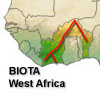Project description |
In African savanna ecosystems fungus growing termites are considered ecosystem engineers as they drastically affect resource flows that change the composition and spatial arrangement of current and future organismic diversity. Old termite mounds harbour a specific floristic composition and thereby increase the phytodiversity in savannas. Thus the occurrence and spatial distribution patterns of many plant species depend on the spatial patterns of termite colonies, as they are restricted to these mounds. Moreover, investigations on the socio-cultural and socio-economic role of termites and the mound-related plants revealed their high importance for local communities. Multipurpose utilization comprises the use of i) termites as chicken fodder, ii) soil of mounds for fertilization and construction, iii) fungus and plants for nutrition, and has applications in iv) traditional health care, and v) cultural and religious ceremonies.
In recent times, mound abundance decreased in our study area in Northern Benin. In order to mitigate this development an integrative research approach (including botanists, zoologists, soil scientists and socio-economists) is designed for evaluating the causes for decline in detail and for developing approaches of more sustainable use in close co-operation with local communities. The aim of the project will be a) to better understand the causes of the decline of some of the local peoples’ socio-economically important resources, namely the termite mounds and mound plants, b) to increase the awareness of local people and c) to develop management recommendations for a sustainable use that are applicable in this region and eventually also transferable to other areas.
|






 Go to the WeatherNet
Go to the WeatherNet BIOTA West Africa - Workpackage - CT2-T2-WP4
BIOTA West Africa - Workpackage - CT2-T2-WP4 Diversity islands of special ecological and socio-economic relevance: Sustainable use of termite mounds and their products
Diversity islands of special ecological and socio-economic relevance: Sustainable use of termite mounds and their products